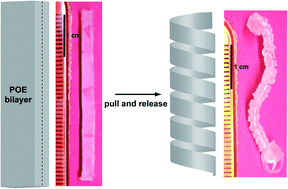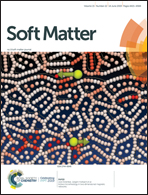Bending, curling, and twisting in polymeric bilayers†
Abstract
Polyolefin thermoplastic elastomer (POE) bilayers of varying length (L) to width (W) ratio are formed through traditional polymer processing. Each layer is completely isotropic but the bilayers have an elastic recovery mismatch such that when stretched, one layer recovers to a different extent than the other. Upon stretching bilayers from low to moderate strains and releasing the bilayer bends (curvature, κ, κ < 1/L). Stretching to moderate strain and releasing results in bilayer curling (1/L ≤ κ < 1/W). Finally, stretching to high strains and releasing such that κ ≥ 1/W results in twisting into a helix for L/W > 2π bilayers and rolling into a cylinder for L/W < 2π bilayers. Varying W can change the helical pitch, lp, of twisted bilayers. The twisted bilayer helical rise angle varies between θ = 60 and 90°. Metastability, i.e., bilayers that show a combination of the two behaviors, is observed at long absolute L or short absolute W. The bilayers are modeled using Euler–Bernoulli beam theory to show that the curvature can be predicted using the elastic recovery of the layer that recovers more.



 Please wait while we load your content...
Please wait while we load your content...